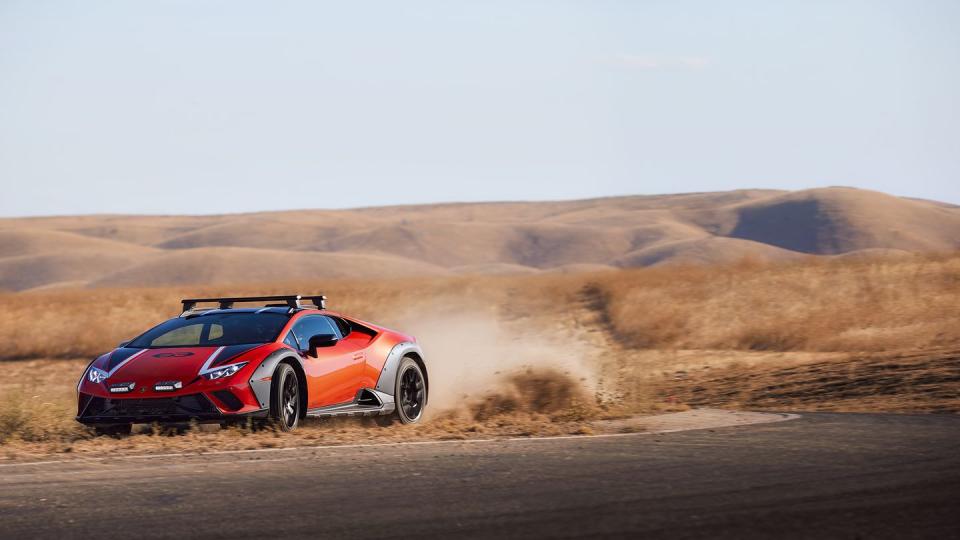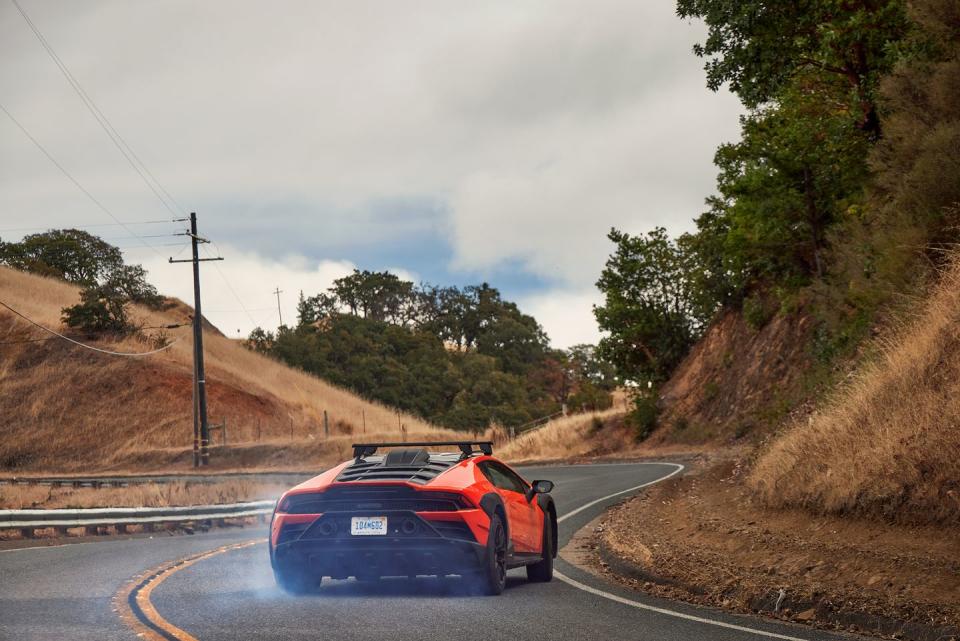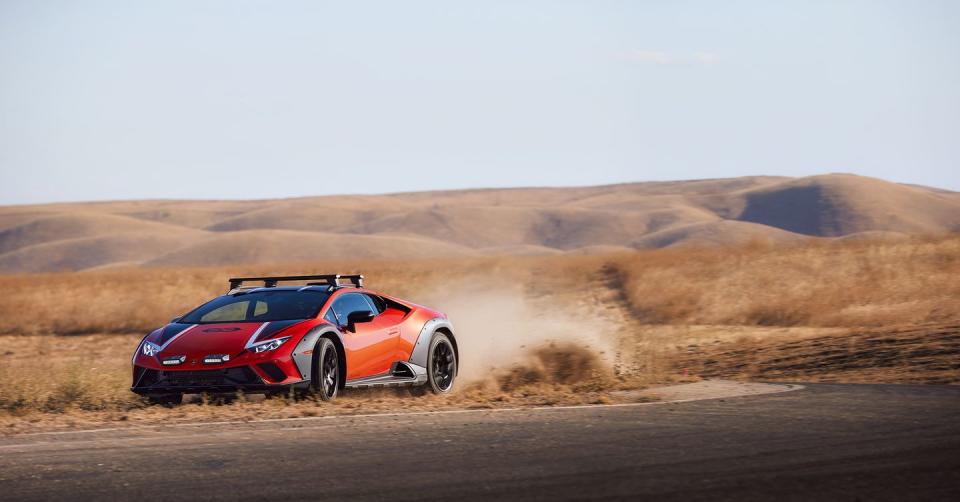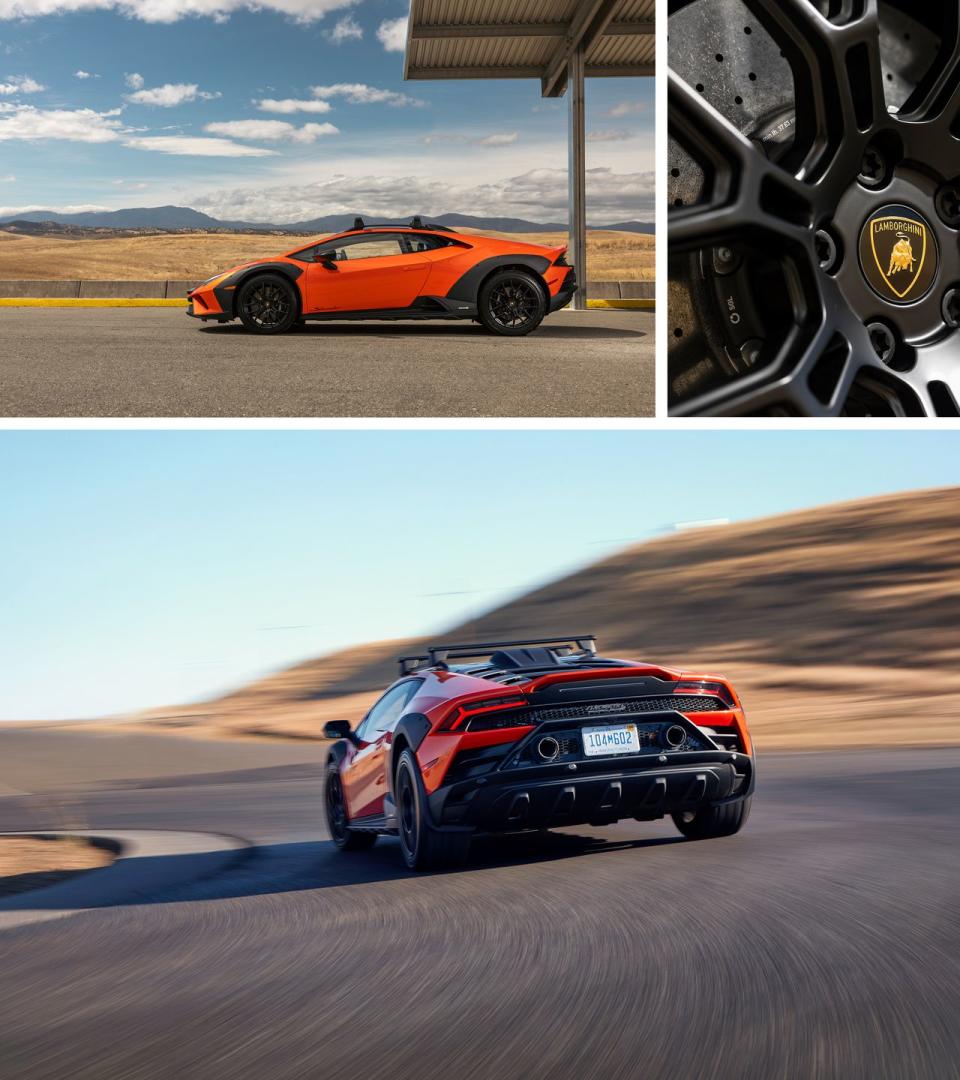Counterpoint: The Lamborghini Huracán Sterrato Deserved to Win Performance Car of the Year


“You’d get kicked out of any track day for driving like that,” my new co-editor-at-large Jethro Bovingdon commented as I returned to the paddock in the Huracan Sterrato, dusty, grilles full of thistle and weeds, bits of plant matter falling from enlarged, flared wheel arches.
He’s right, of course. You probably would not be welcome at your typical High-Performance Driving Event (HPDE, or simply “track day”) stocked with Camaros and 911s, trying to perfect their lines, optimize their times, and checking their tire pressures. Certainly not in a lifted supercar on knobbies, sliding like an absolute loon, sending bits of rubber flying into the air, cutting corners, and dragging bits of earth back onto a smartly prepared racing surface with you.
Of course, this presents a conundrum, particularly to someone like me who makes a living producing videos of such shenanigans. If I did the same thing on the street, someone would inevitably scream, “Take it to the track!”
I’ve been black-flagged at open track days for oversteering out of hairpin corners - apparently “take it to the track,” doesn’t mean to a track day, but rather, renting your own race track all to yourself for this specific undertaking - at a wildly different price point; similarly going from a WRX to a lifted Lamborghini. Attending a track day might cost a hundred dollars, for a local event at a relatively unknown track, to several thousand dollars for an “Unlimited Sound” day at Laguna Seca. Likewise, renting the whole track, which starts at a few thousand dollars, and, at the other extreme, ends at over $70,000 to rent the Nordschleife for a day.

Should you choose to rent a track all to yourself, or get a job at America’s most awesome car magazine, bring along the most absurd supercar on sale today, the rally-ready Lamborghini Huracán Sterrato. You will not get in trouble for drifting every single corner on the track, sending it sideways at every opportunity, even at 100 mph with an easy lift, flick, point, smash the throttle to the floor. You will not get in trouble for destroying a set of specification Bridgestones.
You may get a sternly wagged finger for, as Thunderhill’s otherwise friendly staff put it, “creating a fire hazard,” as you simply ignore where the tarmac ends and the dirt begins, continuing on at an incredible pace, neither car nor driver bothered in the least by the surface change, let alone the presence of plants, rocks, or small trees.
For folks like myself, who grew up on Top Gear, a television show that certainly does not require explaining here, lap times are good, but big angle, smoky drift shenanigans are better. Performing controlled slides in an outrageous supercar is, to many of us, the true mark of what fun in a car should and can be.
But as the cars get faster, more powerful, and more oriented towards stopwatch heroics, with ever more expensive, slick-adjacent tires, the idea that a wealthy enthusiast with both the skill and the bravery to slide their supercar around grows more and more distant, even with cars like the BMW M2/3 and McLaren 720S coming standard with features that encourage and assist sliding.
Where am I going with this? Well, at long last, in 2023 both Porsche and Lamborghini, both of whom have displayed mastery of road car dynamics, finally learned what California residents and many truck and rally enthusiasts have known about for a while: they learned about the desert. And a vehicle that has great on-road dynamics will, in most cases and with carefully considered modifications, display equally great off-road dynamics.
The desert is the last bastion of true automotive freedom. Rules are virtually non-existent in the desert. There’s plenty of space, and very little to hit, and even if you were to have a crash, the likelihood of injuring another person is very very low. The surface is loose, but in many places, not particularly rocky or perilous. You think a 911 or a Huracán is fun on the tarmac? Try one in the desert. I wrote extensively about the 911 Dakar early in this year, and now we’ve convinced Lamborghini to provide us a Sterrato and two sets of tires for Performance Car of the Year. We don’t have a desert, we just have a racetrack but I also attended the Mojave launch of the Sterrato, where I drove it on a rallycross course made up of 2 miles of tarmac and 3 miles of sandy stage course, and had the best time ever.
Lamborghini has, frankly, not had to do much to their Huracán in order to turn it into a rally car. That is not to diminish the accomplishments of their engineers - in some cases, less really is more. The engine and powertrain are left alone, save for a functional roof scoop designed to keep sand out of the intakes. The car is lifted a bit, widened a bit with rhino-lined flares, given some basic skid plate protection and some fog lights, different wheels and knobby tires, and that’s more or less the whole deal. Lambo has reprogrammed the drive modes so rather than “Corsa” we now have “Rally.”
While I can absolutely appreciate the sharpness and motorsport theater that comes with something like the Huracán STO, frankly, I appreciate more the flexibility that comes with the Sterrato. It rides beautifully on uneven road, in many ways better than the 911 Dakar. It has just enough body roll to allow you to find the limit and play there without feeling like you’re going to lose the car. It is unbothered by pretty much anything at all, from hitting a curb, to funny driveway angles, to making a hard turn off the road into the dirt at 70 or 80 miles an hour.

Downsides? Sure, nothing’s perfect. If you’re really trying to drive at ten-tenths on a race track, it gets loose under braking. And why wouldn’t it? That’s how off-road tires with big sidewalls work. In fact it’s not particularly good at ten-tenths driving, period. It’s great at a two-tenths crawl, a six-tenths cruise, or a twelve-tenths send and nothing in between.
But as the Huracán approaches its final years, after a full decade in production, we were starting to think the old girl had nothing left to give. The Performante, the Evo, the STO, and. the Tecneca are wonderful cars, but they are nuanced versions of fundamentally the same thing - lighter, sharper, faster, and then, put the leather back in so people can use them every day. Nothing wrong with this methodology, but it’s predictable and not particularly interesting.

The Sterrato, on the other hand, is a genre-defining car. No disrespect to the 911 Dakar - it too is awesome, but Porsche has been racing cars off-road for 40+ years and it was only a matter of time before we saw a factory 911 rally car. The instant success of Sterrato, not only from a dynamic standpoint but also a sales one (they sold out almost immediately), means that supercars can, and should be rally cars, excelling in road-going comfort and off-road, sideways, rooster-tailing antics that will plaster a smile on the face of even the most jaded collector.
The Ferrari 296 may have won everyone’s vote for Performance Car of the Year, and for its accomplishments, I commend them. But the Sterrato may be the silliest, most fun, most absurd supercar of the last 10 years, the Lamborghini-est of all Lamborghinis.

A car-lover’s community for ultimate access & unrivaled experiences.JOIN NOW Hearst Owned
You Might Also Like

 Yahoo Finance
Yahoo Finance 